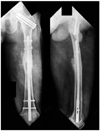Abstract
Purpose
To compare retrospectively the antegrade and retrograde nailing in the management of ipsilateral femoral neck and shaft fractures.
Materials and Methods
Thirty-two patients (thirty-three injuries) were included in this study. Mean age of patients was 38 years-old in the antegrade nailing group (16 injuries) and 44 years-old in the retrograde nailing group (17 injuries). We compared the union of fractures and complications between two groups, and investigated the influencing factors.
Results
Femoral shaft fracture was united in 10 cases (63%) of antegrade group and 12 cases (71%) of retrograde group, at 28.2 and 27.3 weeks respectively. Nonunion was more prevalent in Winquist-Hansen III and IV (5 in antegrade nailing, 3 in retrograde nailing) than I and II. Femoral neck fracture was united with 1 case of nonunion in each group. Nonunion developed from Garden stage IV, but fractures of Garden stage I and II united regardless of methods.
Figures and Tables
 | Fig. 1(A) A 29-year-male with femur shaft fracture.
(B) Postoperatively, femur neck fracture was found on the radiograph (arrow) and CT image.
(C) Fourteen days after initial operation, fixation was done with three screws anterior to the femoral nail.
|
 | Fig. 2(A) At 2 month, femoral neck fracture healed and callus is forming on the shaft fracture.
(B) At 6 month, all fractures healed uneventfully without leg length discrepancy.
|
 | Fig. 3(A) A 61-year-man with ipsilateral fractures of femoral shaft and neck.
(B) Retrograde nailing of the shaft and screw fixation of the neck was done.
|
References
1. Alho A. Concurrent ipsilateral fractures of the hip and femoral shaft. a meta-analysis of 659 cases. Acta Orthop Scand. 1996; 67:19–28.

2. Casey MJ, Chapman MW. Ipsilateral concomitant fractures of the hip and femoral shaft. J Bone Joint Surg Am. 1979; 61:503–509.

3. Chen CH, Chen TB, Cheng YM, Chang JK, Lin SY, Hung SH. Ipsilateral fractures of the femoral neck and shaft. Injury. 2000; 31:719–722.

4. Friedman RJ, Wyman ET Jr. Ipsilateral hip and femoral shaft fractures. Clin Orthop Relat Res. 1986; 208:188–194.

5. Gustilo RB, Anderson JT. Prevention of infection in the treatment of one thousand and twenty-five open fractures of long bones: retrospective and prospective analyses. J Bone Joint Surg Am. 1976; 58:453–458.

6. Hansen ST, Winquist RA. Closed intramedullary nailing of the femur. Kuntscher technique with reaming. Clin Orthop Relat Res. 1979; 138:56–61.
7. Jain P, Maini L, Mishra P, Upadhyay A, Agarwal A. Cephalomedullary interlocked nail for ipsilateral hip and femoral shaft fractures. Injury. 2004; 35:1031–1038.

8. Kim SJ, Oh CW, Ihn JC, Kim HS, Jeon IH, Kyung HS. Retrograde intramedullary nail for femoral shaft fracture with limited indications. J Korean Soc Fract. 2003; 16:45–51.

9. Leung KS, So WS, Lam TP, Leung PC. Treatment of ipsilateral femoral shaft fractures and hip fractures. Injury. 1993; 24:41–45.

10. Oh CW, Kim SY, Kyung HS, Ihn JC, So HT, Lee JM. Difficulties in the treatment for ipsilateral concomitent femoral neck & shaft fractures. J Korean Soc Fract. 2001; 14:152–158.

11. Orthopaedic Trauma, and Classification. Fracture and dislocation compendium. J Orthop Trauma. 1996; 10:1–154.
12. Patterson BM, Routt ML Jr, Benirschke SK, Hansen ST Jr. Retrograde nailing of femoral shaft fractures. J Trauma. 1995; 38:38–43.

13. Randelli P, Landi S, Fanton F, Hoover GK, Morandi M. Treatment of ipsilateral femoral neck and shaft fractures with the Russell-Taylor reconstructive nail. Orthopedics. 1999; 22:673–676.
14. Swiontkowski MF, Hansen ST Jr, Kellam J. Ipsilateral fractures of the femoral neck and shaft. A treatment protocol. J Bone Joint Surg. 1984; 66:260–268.

15. Watson JT, Moed BR. Ipsilateral femoral neck and shaft fractures: complications and their treatment. Clin Orthop Relat Res. 2002; 399:78–86.
16. Wiss DA, Sima W, Brien WW. Ipsilateral fractures of the femoral neck and shaft. J Orthop Trauma. 1992; 6:159–166.

17. Wolinsky PR, Johnson KD. Ipsilateral femoral neck and shaft fractures. Clin Orthop Relat Res. 1995; 318:81–90.
18. Wu CC, Shih CH. Ipsilateral femoral neck and shaft fractures. Retrospective study of 33 cases. Acta Orthop Scand. 1991; 62:346–351.

19. Yang KH, Han DY, Park HW, Kang HJ, Park JH. Fracture of the ipsilateral neck of the femur in shaft nailing. The role of CT in diagnosis. J Bone Joint Surg Br. 1998; 80:673–678.




 PDF
PDF ePub
ePub Citation
Citation Print
Print





 XML Download
XML Download